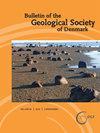丹麦北部马斯垂克白白垩中发现的首个记录(鹦鹉螺)
IF 1
4区 地球科学
Q2 Earth and Planetary Sciences
引用次数: 1
摘要
非典型的晚白垩世鹦鹉螺Epicymatoceras vaelsense(Binkhorst-van den Binkhorst,1862)是在丹麦马斯特里赫特白白垩系的三个标本的基础上描述和说明的。其中一个可能来自Frejlev的马斯特里赫特阶下/上边界层段,而另外两个可能来自Dania采石场暴露的马斯特里奇特阶最上层白垩;这两个地方都在丹麦北部的吉兰。这些是来自丹麦的E.vaelsense的首次报告;该物种以前曾在荷兰、比利时、德国北部和波兰的坎帕尼亚阶最上层和马斯特里赫特阶下统有记录。在达尼亚采石场马斯特里赫特阶最顶端的白色白垩中发现了E.vaelsense,这被认为是迄今为止已知的最年轻的Epicymatoceras记录,表明该属一直存在到白垩纪末。丹麦E.vaelsense的胚胎海螺的直径估计为c。30毫米,基于达尼亚采石场的一个个体,证实了早期的观察结果,即该物种拥有晚白垩世鹦鹉螺中最大的胚胎海螺之一。本文章由计算机程序翻译,如有差异,请以英文原文为准。
First record of Epicymatoceras vaelsense (Nautilida) from the Maastrichtian white chalk of northern Denmark
The atypical Late Cretaceous nautilid Epicymatoceras vaelsense (Binkhorst van den Binkhorst, 1862) is described and illustrated on the basis of three specimens from the Maastrichtian white chalk of Denmark. One of these is probably from the lower/upper Maastrichtian boundary interval at Frejlev, while the other two originate from the uppermost Maastrichtian chalk as exposed in the Dania quarry; both localities are in Jylland, northern Denmark. These are first reports of E. vaelsense from Denmark; the species has previously been recorded from the uppermost Campanian and lower Maastrichtian of the Netherlands, Belgium, northern Germany and Poland. The presence of E. vaelsense in the topmost Maastrichtian white chalk in the Dania quarry is considered the youngest record of Epicymatoceras known to date, suggesting the persistence of the genus until the end of the Cretaceous. The diameter of the embryonic conch of the Danish E. vaelsense may be estimated at c. 30 mm, based on an individual from the Dania quarry, confirming earlier observations that the species possessed one of the largest embryonic conchs amongst Late Cretaceous nautilids.
求助全文
通过发布文献求助,成功后即可免费获取论文全文。
去求助
来源期刊

Bulletin of the Geological Society of Denmark
GEOSCIENCES, MULTIDISCIPLINARY-
CiteScore
2.80
自引率
16.70%
发文量
28
审稿时长
>12 weeks
期刊介绍:
The Bulletin publishes contributions of international interest in all fields of geological sciences on results of new work on material from Denmark, the Faroes and Greenland. Contributions based on other material may also be submitted to the Bulletin if the subject is of relevance for the geology of the area of primary interest.
 求助内容:
求助内容: 应助结果提醒方式:
应助结果提醒方式:


